Fresh fruits and veggies are a staple of our diet. They fuel our bodies and sharpen our minds, but what happens if we cannot access this precious resource?
If you are like me, the current climate in Eastern Europe has grabbed your attention and left you feeling uneasy. The ongoing war between Russia and Ukraine sheds light on the risk of instability that we face each day, no matter where we live in the world.
It shows us the precarious nature of life and reminds us of the importance of preparing for any situation that may arise. Most people didn’t think Russia would ever invade Ukraine, yet here we are.
If God-forbid, something like this were to happen in our homeland, we would want to be prepared, and part of this preparation is having access to fresh, healthy food.
Thankfully, several vegetables can be grown and harvested quickly, allowing you to have fresh food on hand if you need it.
1. Arugula
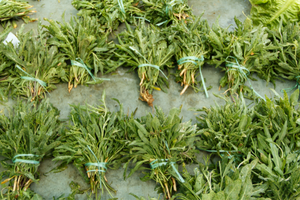
Arugula is exceptionally easy to grow. This plant requires little to no gardening skills and takes around two weeks to reach a harvestable state. Arugula is an excellent option in a crisis and is easy to grow in any environment.
Related: Microgreens: The Most Nutritious Indoor Food Source
Arugula reaches full maturity in 40-50 days but can be trimmed and consumed within approximately two weeks (or when leaves are around 3 inches long) should you need something fast.
To grow arugula, you will sow the seeds and wait. Arugula is not a picky plant, and it will grow almost anywhere.
While arugula prefers cool temperatures and is best grown in the spring or late summer, it will thrive in most environments as long as there is a cool, shady period throughout the day.
When caring for arugula, you will want to ensure that it stays moist by watering it regularly. This plant should be in a location that provides direct sunlight and some afternoon shade.
2. Radishes
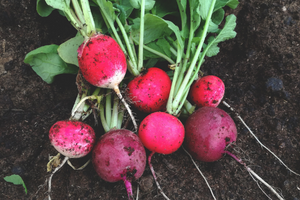 Planting radish is another option that yields quick results.
Planting radish is another option that yields quick results.
When radishes are placed directly into the soil a ½ inch deep and two inches apart, they will grow in as little as four weeks. You will want to plant your radish in a sunny area or somewhere with partial shade.
Too much sun can damage the plant, but too little will cause it to grow large on top while staying small on the bottom.
Best planted in the spring, radishes love cool weather. In fact, you can plant your first batch of radishes a full two weeks before the final frost of spring because they hold up well in cold weather and will not be damaged.
To encourage radish growth, you want to keep the bed wet but not soaked. Water the area evenly and frequently to ensure a healthy crop. Most people suggest watering the site every two days to keep the plants moist and healthy.
The best part about radishes is that they grow quickly and can be harvested within only a few weeks. A general rule of thumb is to allow a radish root to reach around one inch before harvesting the plant.
If your radish plant starts to grow flowers, it is either time to pull the plant or allow it to sprout seeds to germinate.
3. Green Onions
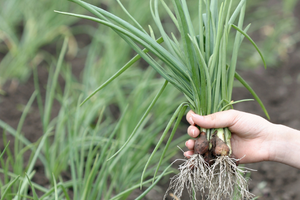 Green onions are an excellent option for use in cooking or salads. This popular plant is easy to grow and takes as little as ten days to reach harvest.
Green onions are an excellent option for use in cooking or salads. This popular plant is easy to grow and takes as little as ten days to reach harvest.
The shoot of a green onion plant can be continuously cut back throughout the season, providing you with a regular, ongoing supply as needed.
Related: How To Start A Survival Garden From Scratch
You can grow green onions from seeds or from the base of onions you have already used by placing the white bottom of the onion into the soil of a planter or directly in the ground while leaving a small portion showing through the top.
Green onions can withstand the cold but will not grow as quickly in temperatures that produce frost. Green onions require around six hours of sunlight per day, and their bed must remain moist. Be sure to water the plants often to encourage a healthy harvest.
While some people opt to fertilize their onions every two to three weeks, you can produce robust and healthy onion plants without fertilizer as long as they have water and sunlight.
Green onions can be placed relatively close together and thrive in small environments like a pot on your kitchen window sill. Place each plant or seed approximately one inch apart to give the roots enough room to gather nutrients and grow.
4. Kale
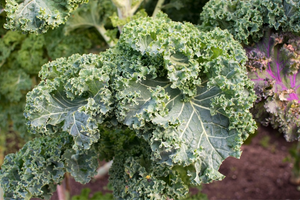 Kale is essentially a form of cabbage that has gained popularity in recent years.
Kale is essentially a form of cabbage that has gained popularity in recent years.
High in nutrients, kale is an excellent option for a fast-growing vegetable used in various meals. Growing kale will take approximately two months from seed to harvest and is best planted in late winter or early spring.
Kale can be planted three to five weeks before the last frost in your area, or in the late summer, three to six weeks before the final fall frost. It can grow in various planters or spaces, from planter pots to garden beds. This plant is hearty enough to survive and thrive almost anywhere.
Kale should be placed around 1 ½ to 2 feet apart to allow the roots to spread and absorb all the nutrients it needs. Plants should be placed around ½ inch deep, and no support structure is required.
Kale plants do best in direct sunlight and should receive six or more hours of sun per day. Watering should occur regularly, with the soil staying moist but not soggy.
Kale plants will take approximately two months to mature from their seed state. However, young kale leaves can be harvested early and used in salads or cooking. Removing older outer plants will also allow the center of the plant to continue production.
Fresh kale can be easily stored in the fridge for a week, frozen for later use, or used to create cuttings that enable you to grow new plants.
5. Spinach
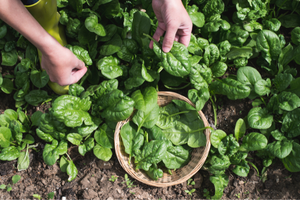 Unlike some other seedlings, spinach will grow in partial shade and requires far less sunlight than other plants.
Unlike some other seedlings, spinach will grow in partial shade and requires far less sunlight than other plants.
Three to six hours of daylight is enough to produce healthy, robust spinach plants that are ready to harvest in as little as a month. The ideal site for growing spinach is a relatively sunny place.
You can also grow spinach in pots if you desire, which is especially useful if you live in a hot, dry climate. When planting spinach in pots, ensure ample drainage for excess water to be released as needed.
Spinach plants should be planted ½ to 1 inch deep and spaced 12 to 18 inches apart. You can separate and thin plants that have sprouted to around six inches apart once they have begun to grow.
While spinach does best in direct sunlight, it will grow in partial shade. The soil of your spinach plants should be kept moist, and organically rich soil will encourage growth.
Regular watering is essential in warmer climates where the soil may dry out fast. Spinach will require 1 to 1 ½ inches of water per week and prefers temperatures around 50 to 60 degrees.
Related: 10 Survival Crops You Can Grow Without Irrigation
Spinach will take around 4 to 6 weeks to reach a harvestable state. You can trim spinach in a way that allows it to regrow, often referred to as the ‘cut and come again’ method.
Spinach can be eaten raw or cooked and is a popular vegetable in many recipes. You can easily prune the leaves of spinach throughout the season, providing you with a tasty meal and keeping the plant healthy and fresh.
6. Zucchini
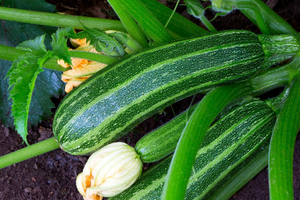 Zucchini likes warm temperatures and does best when the weather is warm.
Zucchini likes warm temperatures and does best when the weather is warm.
Direct sunlight is best for large zucchini, but partial shade will work fine if you only grow for the leaves and stems. Aim for around 3 to 6 hours of full sunlight wherever you choose to plant your zucchini.
It takes zucchini around five to six weeks to grow to full maturity, and it should be planted two to three weeks after the last frost in your area. Zucchini does not do well in the cold, and even small amounts of frost will damage the healthiest of plants.
Zucchini is ready to harvest when it reaches around four to six inches in length, and all parts of this plant are useable, making it an excellent addition to any garden. Many gardeners say that zucchini practically grows itself, and plants can produce an ample harvest without much care.
This fast-growing vegetable will provide you with an ample harvest within 40 to 50 days, provided it is well watered to keep the soil damp. A deep watering once a week is usually enough in most environments.
Zucchini loves the sun, and planting in a sunny area with rich soil will encourage crop growth. Keep zucchini plants a ½ inch deep, and be sure to space them around two to three feet apart.
7. Turnips
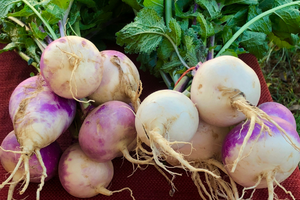 For centuries, turnips have been grown in gardens around the world. This popular root vegetable is easy to grow and quick to mature.
For centuries, turnips have been grown in gardens around the world. This popular root vegetable is easy to grow and quick to mature.
Turnips thrive in cool temperatures and are best planted two to three weeks before spring’s final frost and also do well in the fall months.
Turnip seeds should be placed in their final resting place as they do not transplant well. Ensure seedlings are around six inches apart and keep the soil cool and damp with regular watering.
Smaller spring turnips will be ready to harvest in as little as four to six weeks, and tender greens can be harvested in as little as two.
Turnips grow best in direct sunlight, so choose a well-lit area for these plants. Turnips also require soil that drains well but remains somewhat damp.
Watering turnips is vital for good rooting, and around one inch of water per week is usually sufficient. The better the moisture in the soil, the more uniform the turnip will be.
8. Cherry Tomatoes
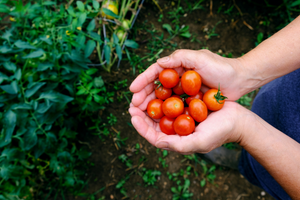 In as little as two months, you can have an ample harvest of these tiny and delicious morsels.
In as little as two months, you can have an ample harvest of these tiny and delicious morsels.
Cherry tomatoes grow so abundantly and with such little effort that you will be giving them away to anyone you see. Choose a sunny location that gets around 8 hours of direct sunlight a day.
You can quickly start cherry tomatoes indoors and move them outside after the fear of frost is gone in your area.
One of the most popular garden crops, cherry tomatoes are easy to care for and create a plentiful harvest for any gardener. You can also grow these plants in containers and get similar results to growth outdoors.
Plants should be spaced a few feet apart and covered in ¼ inch of soil. Tomatoes of any type do require a structure to encourage vine growth. A simple tomato cage will allow vines to climb and spread in the sun of your garden.
Light is the heart and soul of cherry tomato gardening. This plant should get plenty of direct sunlight to encourage vegetable growth. Watering is also essential to success, and you should aim to water this plant deeply every few days.
9. Mustard Greens
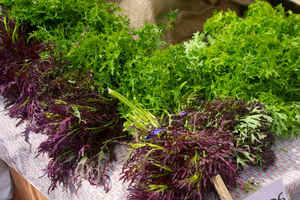 Easy and fast to grow, mustard greens can be an easy option for gardening and getting greens. Mustard greens require a well-watered area, as they turn unpleasant if allowed to dry.
Easy and fast to grow, mustard greens can be an easy option for gardening and getting greens. Mustard greens require a well-watered area, as they turn unpleasant if allowed to dry.
While mustard greens are not as hardy as kale or other plants, they can withstand a light frost.
However, this plant is sensitive to heat and does best in the spring and fall.
Mustard greens should be harvested when the leaves are large enough to eat.
10. Cress
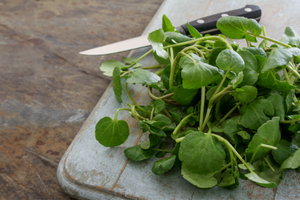 Cress is a green popular among gardeners because of its peppery flavor and fast growth. Often used in salads and soups, cress can grow throughout the winter months, providing you with a year-round microgreen option.
Cress is a green popular among gardeners because of its peppery flavor and fast growth. Often used in salads and soups, cress can grow throughout the winter months, providing you with a year-round microgreen option.
This plant is easy to grow indoors, and seeds can be germinated on a tray covered in a wet paper towel.
Many people find the pepper taste of cress becomes too strong during warmer months when grown outdoors, and thus, this is an excellent indoor winter option to get needed greens.
If growing cress outdoors, choose an area with a good amount of shade and ensure that you water the crop regularly.
Cress seeds will sprout in approximately five to fifteen days and should be thinned to six inches apart once they reach an inch or two in size.
11. Bok Choy
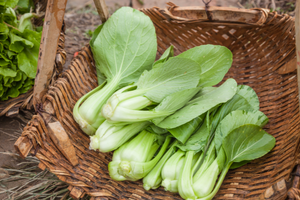
Yet another quick-growing vegetable that is popular among gardeners is bok choy. It should be planted in partial shade and watered consistently to encourage healthy growth.
Depending on the weather in the area, bok choy should be ready to harvest in approximately 45 to 60 days.
There are two varieties of bok choy, regular and baby bok choy. Both types are planted in early spring for harvest in early summer. This plant can also yield multiple crops if properly trimmed for growth encouragement.
A well-draining location with rich, fertile soil is best for bok choy. Plants should be placed a ½ inch apart and around ¼ inches deep in a sunny spot, primarily if you aim for a fall harvest. While sunlight is essential to any plant, bok choy does well in areas that have partial shade.
Leaves from a bok choy plant are harvested from the outside of the plant, while interior leaves are left to mature and grow further.
Once all leaves have been gathered, you can cut the plant one inch from the base, and it will often resprout. The resprouted plants will be smaller in size but equally delicious.
You may also like:
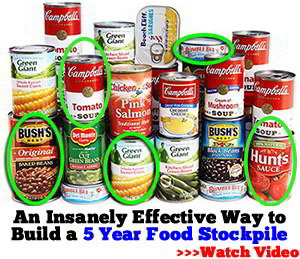 Survival Uses For Drinking Straws You Normally Throw Away
Survival Uses For Drinking Straws You Normally Throw Away
How To Make A Year-Round Self-Sustaining Garden (Video)
What Is The Closest Amish Market To Your Home
10 Expenses You Need to Cut Now for the Upcoming Economic Depression

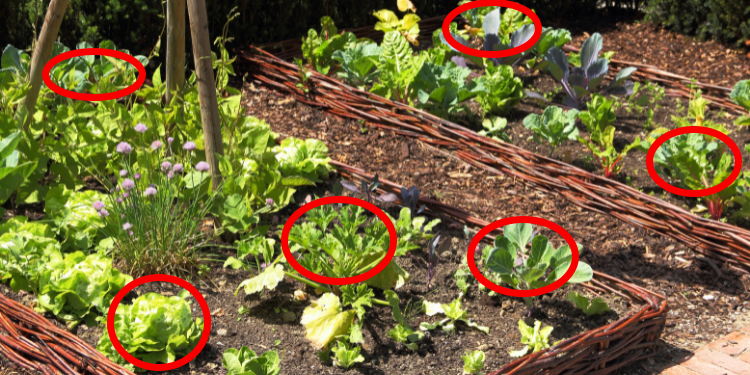













This is very interestiong, especially whit my family thank you will save and do for sure !
Had a little garden every year that was possible for me… love it
A follow up I would LOVE to see, as I’m only sure for the obvious plants like corn, pea’s, beans, … would be how to harvest and store the seeds for the next crop.
We could certainly use some info for gardening in central & southern Arizona. None of the typical sources make any provision growing gardens in our climate.
Try Malabar spinach–it LOVES very hot weather! There are seeds available online. I will say the Malabar spinach has more ‘fleshy’ leaves, not quite like the cool weather spinach you are used to growing. But it steams very well, if you aren’t as keen on the fresh texture. Lots of the above mentioned veggies would be great planted in October here in the desert SW, and will provide great harvests from October through April.
Does the ‘weed’ lambs quarter grow near you? It tastes like spinach (actually better) is more nutritious and a weed. I even have some canned in my larder.
Desert: True. I’m still re-learning what Apaches and others taught me years back. Even local plants like some protection from sun and wind their first year in the ground. Last year at Lowes, I picked up a cherry tree. The tag says it’s a Spanish Capulin, but the blooms look like a capuli (long strings, not small clumps), the cherry trees Indians planted around pre-Columbian schools, and it’s in bloom at a very young age. So far, not even citrus can out-tough this one.
It’s about time to start the cowpeas/green beans. Already have early sweet corn in 6-packs. this is zone 9A, so anything planted on the south side of the house survived and produced most of the winter.
are you near Tucson? A man down at the Air force parts yard is selling steel military-grade barrels for 15 each. The lid seals and locks with a bolt. Very clean inside, they were used to haul ordinances. niio
Hey Red,
I’m in Tucson, AZ. Guess this post was 2 years ago, but if you’ve got a line on those barrels, I’m interested. Write to me at: ne2a@baluns.com
Check out Audrey’s Little Farm site as she is in zone 9 for hot weather gardening information.
Thanks for an interesting and well presented article.
Am trying to grow more stuff at home in an effort to be more independent of the failing supply chain.
Malabar spinach seeds, bok choy, and others are available at Baker’s Creek Seeds.
No mention of the lowly potato?
They aren’t fast growing.
You plant potatoes in March and harvest them in September. They are not terribly quick to grow. You can harvest a few new potatoes earlier , but in a survival situation if you can leave them until they are full size it would be better.
For those like me who do not care for zucchini, most any type of squash does very well also. Last year I tried planting crook
neck and straight neck yellow squash together. Maybe it was a coincidence, but the crop was HUGE, much better than my usual harvest of the same number of just straight neck plants.
Crazy squirrel:
True, potatoes aren’t fast growing, but sweet potato Vines are and are an edible green.
There weren’t many veggies for “bulk” or starch, but most greens are nutritional powerhouses of vitamins.
I would suggest you also checking around for wild sources of food near you to provide the necessary energy for survival, or having a good supply stockpiled. Here’s where the ubiquitous beans and rice come into play, or lentils and millet, quinoa, amaranth, chia, and so on. Legumes and grains have kept people alive in poverty/famine situations for millennia. Greens are the ancient equivalent of vitamin supplements.
This is a topic I’m always interested in. Having a great assortment of seeds prepared for long-term storage, how do you get food in the quickest way possible.
Dale start a garden. Having seeds doesn’t get you the skill set for your area. Read the other commenters about how varied their gardening skillset and frankly the selection of food crops that will thrive there.
You tube, discussions with other gardeners and all that is good but DIRT TIME and learning from your mistakes and failures is key.
Once you’ve grown a bean patch, struggled with watering, weeding, fighting off the pests and critters trying to eat it up. Then harvesting them and drying them (again keeping pests away as buggy dry beans isn’t good) You should be amazed that you can buy 8 pounds of dry pinto’s for less than 6 dollars. That’s the production of a small patch of beans well kept.
You have seeds, are they good for your area? Do you have the growing zone to allow them to mature to eating stage? Here in still semi-frozen New England I love sweet potatoes but I have to do a lot of early and late gardening interventions to warm the soil early and keep the sweet potatoes soil warm enough later in the season to get a crop.
But I’m stubborn and love sweet potatoes so I grow them anyway along with my plain Irish potatoes. Honestly I get more calories from the plain potatoes for the work involved.
Prior to Grocery stores and 365 days a year Bannas flown in cheaply, Spring was known as the starving season. Root cellars were down to shriveled bits and bobs, the canned and salted away goodies were looking skimpy and it was several weeks until the first plantings would fill your plate.
The old phrase “Don’t eat your seed corn” comes from that era where families had to decide if eating the seed corn today because they were hungry vs planting them and waiting the some 3+ months to get a harvest (IF hail storms, drought, deer, racoons and bugs don’t get them first).
There’s a good reason the population of the USA in the 1890’s was but 100 Million or so compared to the 330 million today. There’s a reason folks were thought of as old at 45 years of age.
But enough of them survived and have children so we are here today. Humans are stubborn 🙂
Plant potatoes, it’s a start.
Michael,
I have a garden.
In 2019 I bought seeds in bulk. It turns out that you can get a 20 year supply of seeds for about twice the price of a packet of seeds and it generally takes two packets for our garden anyway. So I divided up the seeds into paper envelops for 10 years of regular gardening (which still means huge excess of seeds per year) and also 5 smaller packages (really big enough for a year’s gardening on their own) that I use to test germination every other year. I’ll be doing the second germination test this year. Even though last year wasn’t a scheduled germination test, I did one (using the test package planned for 2028). The onion seeds, which were 2 years old, still germinated at about 75%. All the other seeds were even higher. Onion seeds deteriorate fast so those are the canary in the mine, so to speak.
I put a year’s worth of the paper packets for the 35 different vegetables/varieties, into a single Mylar bag (and did this 10 times), dropped in an appropriate desiccant package, and sealed the Mylar bag. I did the same with the 5 smaller sets for germination tests. Then the whole lot went into the freezer. Actually, gave away one of the 10 yearly packs leaving me 9 and then I put 6 of them in the freezer in my country home and 3 in my city home. We lost power twice in the summer in the unoccupied country home so I’ll be anxious to see what germination tests show this year.
Even though I have these long-term seeds stored, I haven’t opened a yearly pack yet because I save my own seeds as much as possible. I also buy seeds locally each year for those I can’t save or wasn’t successful in saving. I buy enough new each year to put one more year’s in the freezer but the local purchases aren’t planned for survival; I just buy what I want or what interests me and use some and save some. Those give me some backup in case of total failure of seed crops and seed storage.
But what happens if SHTF this week? We always have enough canned foods to last until the garden produces but what if something happens to the pantry? Or what if we just spent the winter living on canned foods and are simply anxious for a change of pace. Since several of the vegetables listed in the article aren’t in our regular diet or gardening, articles like this one help us to plan what additions to make to our plans.
I’ve been doing research, trying to find the quickest carbohydrates and protein I can grow for some fresh food, on-and-off this winter so this article is very timely for me.
Even if the pantry fails, we also have grain storage – wheat, oatmeal, rice, etc. This is just one more angle to solving a world of potential problems.
All that said, your advice is sage and anyone else without a garden should read it and heed it.
Michael: When in warm Zone 4/cool 5, we got a few of those hanging grow bags on sale. they were hung from the edge of the porch and sweet potato slips planted in the bottom. I had a lot of awed neighbors, Dominicans and Puerto Ricans, who couldn’t believe anyone could raise them in that area. they did very well, and I gave away most of the greens. When it got too cold at night, they were hung from the basement ceiling. The last was eaten in March, I think. when I went to find more grow bags, they were sky high because everyone was buying them. niio
Dale, I did some research about your question. Thanks for the motivation 🙂
“I’ve been doing research, trying to find the quickest carbohydrates and protein I can grow for some fresh food, on-and-off this winter so this article is very timely for me.”
Searching for high carbohydrate foods and then looking up the growing cycle I found many options. Also searching for high protein crops and growing cycle.
The top performer in both searches and with an 80-90 day growing cycle is Pinto Beans. Actually, most beans are of similar nutritional profile, but pintos grow easiest and a few days quicker than most.
Pinto beans nutrition (Phaseolus vulgaris), Raw, mature seeds, value per 100 g. (Source: USDA National Nutrient data base)
Principle Nutrient Value Percent of RDA
Energy 347 Kcal 17%
Carbohydrates 62.55 g 48%
Protein 21.47 g 38%
Total Fat 1.23 g 6%
Cholesterol 0 mg 0%
Dietary Fiber 15.5 g 41%
Vitamins
Folates 525 μg 131%
Niacin 1.174 mg 7%
Pantothenic acid 0.785 mg 16%
Pyridoxine 0.474 mg 36%
Riboflavin 0.212 mg 16%
Thiamin 0.713 mg 59%
Vitamin-C 6.3 mg 10.5%
Electrolytes
Sodium 12 mg <1%
Potassium 1393 mg 30%
Minerals
Calcium 113 mg 11%
Copper 0.893 μg 99%
Iron 5.07 mg 63%
Magnesium 176 mg 44%
Manganese 1.148 mg 50%
Phosphorus 411 mg 58%
Selenium 27.9 μg 51%
Zinc 2.28 mg 21%
Phyto-nutrients
Biochanin-A 0.28 mg
Genistein 0.17 mg
Daidzein 0.01 mg
Kaempferol 2.4 mg
Beans are not a complete protein requiring the addition of whole grains, corn or rice as pointed out in much of South America, Africa and Asia.
However, the amount of micronutrients missing from beans requires a tiny amount of actual meat. A single medium egg daily for example would cover the lacks.
So I suggest you look towards fish traps, and other pest control traps. Many a meal I ate in Asia had but a few minnow sized fish in them. Given the number of parasites in the rodent family that inflict trouble for humans the "Survival Rat Trap" is not recommended unless your supplanting your chickens proteins by taking the killed rodent, cutting it in half and allow your girls to go for it. Only bones and fur will remain.
I've watched my girls chase and eat small mice in the chicken yard.
During the Great Depression the deer and such were wiped out pretty soon (thus the post war Wildlife hunting season laws) but trapping nuisance critters kept my families stew pot full as well as reducing the troubles in the garden and hen house.
No matter how hard fished a healthy pond always has minnows.
Michael, great tips. We grow small red beans; they’re not as prolific, I think, as pinto beans but they’re our preferred dry legume. A half-pound of seed yields us about 20 pounds.
Beans and whole wheat bread have been a staple in our house for 48 years. But beans are a summer crop and not a quick-available spring crop.
The idea of eating rodents doesn’t appeal to me but to feed them to pigs or chickens is a good idea. I’m hoping to get a chicken coop started this year, along with honey and rabbits. I’ll buy bulk seeds for sprouts for the animals and have been studying what weeds and other plants around the property would be good for feeding them.
Dale: If you have poultry, you’ll have rodents.
With the major interest in getting animals off grain, sprouting greens is a major business 🙂 It takes 6 days to sprout and raise a pan of grain. Process is the same as human sprouts. niio
Michael: You are absolutely correct about starving people eating their seeds for their next garden. This happened only 1 1/2 years ago with the church congregation of friends in Uganda, when people were often locked down/lock away from jobs. They got so hungry, they ate their seeds for next year and had nothing to plant when the next gardening season started! Fortunately for the few church people I know in Kampala, a generous American lady sent them money to buy more seeds at the very end of planting season, and they were able to scramble and plant +/- as usual.
I also have friends in another area of Uganda. They have a few fruit trees and always grow a sizable “crop garden”, so they can sell food at the farmer’s market. Well, the drunken neighbor kept sneaking over to their garden at night and stealing the unripe bananas to sell to other starving people! You can cook green bananas, and they taste pretty good! BUT, finally the husband at that place went over to see the neighbor and told him if you steal from us again, we will have the police come get you and lock you up for a LOOOONG time! Fortunately, that stopped the neighbor from stealing food from my friends. Yet, this was very common in Uganda during the Covid lockdowns. As a matter of fact, we knew of a church that had 175 families without food that were starving TO DEATH during that time. My husband got his once a year profit sharing check from work, so we were able to send a lot of the tithe to feed that congregation, and they still talk about how the food came just in the nick of time! We are grateful to be able to help others every now and again!!
Dale: Sprouts. ! cap of bleach per gallon of warm water. Soak the seeds for 45 minutes, then rinse well and set to sprouting.
Black winter radishes are bolting, and the seed stalks are good, but have to be peeled. the seed pods are great, but the main thing is plenty of seed for the new planting year. because of the heat (110F) in summer, only the first seed pods are collected to plant. the rest go as snacks. Kohlrabi, collards, regular rashes and so on, the same. they make good sprouts.
Put in more asparagus. tasty but only a short season, then nothing from the patch, unless double-planting. Agaricus mushrooms like the heat and like the shade asparagus ferns provide. a heavy layer of straw mulch makes them grow well. Once in the bed, they should last as long as the asparagus, 20+ years. niio
red, more great ideas. I do love sprouts but haven’t grown any yet. I’m the only one in the family that will eat radishes so we don’t grow them but I’ll have to start. I hadn’t realized how much of the plant you can use in the ways you suggest.
Mushrooms under the asparagus is an interesting idea. Do you do that? And, if so, for how many years has it worked? We do love mushrooms and I’ve grown tons of them in my mind and on the Internet but haven’t grown any in real life.
Dale: I tried it with oyster mushrooms, but the spore was old. There’s a 5 lbs box of agaricus on the way. A vlogger in Tucson does this every year and she gets a lot of ‘shrooms. I am hoping… 🙂
Oops, no more walking around the house barefoot. I went to clean off the stove, stopped and saw what looked like a small mess shaped like a scorpion. It wasn’t a mess but ran off to hide. yeah, well, all a part of living in paradise. niio
green onions can be started from cutting the roots off of market onions (leave3/4 to 1 inch of onion) and planted in 3 or 5 gallon buckets. you can plant 12 or more in each one. I fertilize with miracle grow about 1x a week for peak performance. At harvest, use a sharp knife to to cut off about 3/4 to 1 inch above the soil. The remainder will resprout and grow another… I have a couple of pots that i’ve harvested 5 or more times… They grow inside (with light) or out, and are somewhat winter hardy, 4 to 6 buckets will provide enough for a continuous harvest on a weekly basis of my use.
Finley diced they dry up well in my dehydrator for later use of any excess…
But that bottom 3/4 to 1 inch are my favorite part. I’ve had success growing with as little as 1/4 inch remaining with the roots but it seems to take longer to get a viable product grown.
Karl: Those green bunching onions in the store hold up well to multiple cuttings. niio
Red:
Green onions are also a good cut and regrow potherb. Stick the white ends in a glass of water and keep the water changed regularly and they’ll grow in just a few days.
I made one bunch last over a month that way.
Excepting turnips and maybe zucchini this is more of a boutique garden than a survival garden. The plants have very little nutritional value, generally a cup of any of them is going to provide 25 calories and 25% of daily C, not much else besides flavor and being pretty. In a world after SHTF survival follows a simple law of economics. Whatever you put energy into has to return more energy or you starve. Gardening is a lot of work and takes a lot of resources so you have to grow corn to feed your animals and also provide you energy, corn, beans, potato, sweet potato, these are your nutritionally dense foods that will show profit from your labor. It’s much more efficient to learn the wild spring greens in your area so you can exploit them for vitamin and mineral support after a starving winter. Bastard Cabbage! Invasive Southern European member of the mustard family, spreading everywhere on its own, no need to prepare the soil, plant it, water and fertilize it, bounty of nature all around us!
Judge: wild mustard is a bad one. down here, it’s Chinese wild mustard and rocket. Add to that, Bermuda grass, which at least gophers and ground squirrels like.
Winter was dry, and packrats had a population boom. The neighbors did not get back from Montana till into spring. Net result, no one was there to spray the morning glory vines, so packrats had a feast on the roots and leaves. I did figure some good on them, tho. I’ve been using fish emulsions as fertilizer and the ‘rats can’t hack that. niio
Book Choi is an invasive plant even in interior Alaska….whether that’s a good thing or bad is a personal choice as long as you’re prepared!
Anyone have good, time proven methods of storing root crops? I’m looking for specific instructions which do not include canning or leaving them in the ground.
I’ve tried sand & sawdust in Grandma’s root cellar w/o success. Unfortunately my grandparents were gone long before I was aware of the need for their wisdom or even in the position to speak with them…1300 miles and very expensive long distance toll calls.
Any real life wisdom one of you wishes to share?
One thing I suggest is start doing it. It’s spring. Most root vegetables are cool weather so you should be planting a bunch of beets, carrots, turnips, and more. Plant way, way, more than you want and create as many experiments as you possibly can – and report back on your results. If the world doesn’t end (and it almost certainly won’t) before next spring, repeat the successful experiments and try some more new ones. Again, let us know how it works out.
Mterndog: Are you storing root crops in the the same soil they came out of? It’s worth trying. Potatoes need cool damp air. Onions produce sulfuric acid that causes other things to rot. Apples produce a lot of CO2, which can do the same. If the air goes below freezing even for a short time, it can cause rot in them.
Side note, a friend from Belarus Russia said because of the cold winters, they stored their mother’s potatoes in the bathtub. They were assigned to a tobacco commune but each family had gardens. niio
Onions hang in net/nylon stockings with each steppe rated by a loose knot then hung in cool, dark basement. Apples end up going soft…in-laws used to store them in the water shed with some success. After 40+ years I just learned to not clean the dirt off the potatoes ( excessively clean as in rinsed), boy did I feel stupid with that one! I’ve tried sand and sawdust for carrots and beets w/o success, they sprout, whither or mold. Leaving anything in the ground here is like ringing the buffet bell for the deer & elk.
The older folks (grand parents) used to store root crops in root cellar but that source of knowledge is lost.
Mterndog: then use peat moss. If I could store sweet potatoes thru winter in a cool basement, peat should keep root crops well. Yeah, the springhouse and a second root cellar for apples. They also aged meat in the springhouse. niio
There was talk about a survival garden. Last year I planted 4 double rows of Provider beans (bush beans) in a 12×4 raised bed. Talk about a survival crop, every time i picked beans (which was every few days) and I canned 8 QUARTS every time I picked, and gave a bunch to several neighbors. THAT is a survival crop!
With my kale and chard, I threw a bunch on a couple trays in my dehydrator (just all willy nilly and not just in one layer, and dehydrated on a fairly low heat and left them over night). In the morning I put them in a bag and crushed them up and use them in soups and stews for extra nutrition. I also dehydrated small squash cut in fairly thin pieces, and cherry tomatoes sliced in half, and some bigger tomatoes in slices. All are good to add to soups and stews.
All garden is all organic and I add Atlantic kelp and azomite to all my raised beds for added rare minerals.
I would add sprouts to the list. A pound of seeds and a jar and you can have sprouts full of nutrients in a few days.
Illinio: Hidden gardens. Make the flowers eatable ones and you have a salad garden hidden in the open. Still waiting on the dahlias (eatable roots) to come up, but the canna are pushing up. carrots are in bloom making seed for next fall (let them self-sow) Wild tobacco is all over now. Safflower (likes the heat and dryness) is mostly in. When it blooms, it makes a large flower and a spoonful of seeds. I just gave away a small lemon tree and have a lot of black Pakistan mulberry cuttings rooted, 2 kinds of fig cuttings rooted, and pomegranate cuttings that are rooted. If you lived closer, I’d bring you some LOL. 100+ peanuts are started and those are considered very ornamental. 2 sisters have blueberries all over–as ornamentals and food. Hide what you have because the pea-brain left would steal the joy of candy out of the mouths of starving children, let alone steal everything from anyone who works for a living. niio
couple of tangent discussions concerning survival gardening besides the fast to harvest – early spring plantings and edibles that are self hiding for some guerilla gardening …
example: you’d be surprised how few people recognize a carrot in the wild – sprinkle the carrot seed among a flower planting and the “carrot tassle” is nothing but a decoration to the non-gardener ….
good example of both early & hidden >> the cabbage family – you can plant in the snow and some varieties are as colorful & shaped as interesting as flowers ….
Illini: Some garden vlogger in Michigan plants his onion seed in the fall and early winter. niio
For all those who missed this story, we also have an epidemic of bird flu in the USA that’s wreaking havoc on domestic flocks. Here’s a link to an article about it.
http://themostimportantnews.com/
There’s another article there about the projected bad wheat harvest. This is getting real, everybody.
Miz Kitty: the last epidemic was traces to, guess where, the nation bird sanctuary in Cuba. Now, thanks to dem supporters and non-voters, chicoms are doing experiments with it. niio
Red:
Not to mention all of those deceased voters who vote in a unanimous block for the Dems, and those who exist only on paper ballots, such as those whose ballots were “lost, but now are found” and which, miraculously multiplied to the exact number needed to carry their district. Between the dead, the imaginary and the multiplied, it truly was a miracle that Biden was elected. ?
Miz Kitty: the story goes even joe didn’t vote for joe, by accidentally hit the straight repub ticket. While there are people who voted for him, they were trump haters, not normal people. Dominion elected biden. soros is invested in dominion and soros wanted a puppet. with dems, the slave trade is sacrosanct. Trump killed most of the trade and pedos like biden had to leave the country to find kids. niio
War and famine have happened in the US before and will again.
1. Arugula: a winter green here. Like rocket, it gets bitter and tastes bad once it starts to bolt. But, it kills a lot of nematodes.
2. Radishes: another winter crop here, but radishes planted in the fall can be harvested in winter without damage to the root. If the temp drops below 25F, you will lost the crop.
3. Green Onions: Good one for here in all but the heat of summer. We buy those little bundles of scallions at the store and separate, then plant in peat with some compost. Tops are cut off an inch above ground. If allowed to ‘mature’ (takes about a month) the roots get strong again and we get one cutting after another. The best found so far is I’itoi, which was brought to Mexico on the Spanish black ships(owned by the king for trading with Asia). They die back in summer, but come the monsoons, are back and each can divide as many as 50 times. Bpttoms can be replanted for new beds.
4. Kale: Great all winter, iffy come summer. Collards take both the heat and freezes in stride and are not sensitive to wind and a little drought.
5. Spinach, disgusting flavor and contains oxalate which interfere with absorption of iron.
6. Zucchini. Someone once called zucchini the blasphemy of squash. Ditto crooked neck. Matured, they’re reasonably eatable. Immature, best use is pasta primavera. They also make a good squash soup (female flowers and male blooms simmered in milk). Immature winter squash all around taste much better and shouldn’t be watery.
7. Turnips are great raw, hold up well in storage (buried in damp earth) and make a fairly good kraut. They do well in the heat, as long as it isn’t too hot. The greens taste better than mustard.
8 Cherry tomatoes thrive where other tomatoes wither. Planted in a 25 gallon tub that sits on the south side of the house, a Texas Wild bloomed and bore fruit all winter.
9 Mustard greens. Arugula is in the family. Best use of mustard greens is the seeds for sprouts or to make mustard.
10. Cress is good, very good! Nasturtium leaves and seeds are even better.
11. Bok choi: another good one.
Be warned, most of these are in the same family and attract the same pests.
Garden-wise, amaranth is into self-sow, so each summer it comes up thick in two beds. Not a problem because it makes shade for late summer planted things, like kohlrabi and collards, turnips, cabbage, and so on. Birds feast on the seeds and eat a lot of bugs, as well. By the time the seed heads mature, the weather is cool enough for all those members of the cabbage family and they mature at a rapid pace. We like Tarahumara because it only grows 5-6 feet tall and is wind resistant. A persistent patch of Red Merlot come up on the other side of the garden and need to be tied up, they can get 12’ tall. No matter how big the leaves, both varieties remain tender. If you live in razorback country, watch out because pigs love them and another amaranth, pigweed. Modern farmers take advantage of this by running hogs in fields infested with any amaranth. Pigs rip out the greens and chickens carry off the seeds.
Red: Our amaranth grows well, too, but we eat the leaves waaaay before they get to the sizes you are talking about. I grow it between the sides of a square “trellis” of cuke vines. It takes right off, and it scrumptious stir fried with onions and garlic!
Has anyone tried growing quinoa?
Next up…a happy mistake ordering dried while peas led to adventures in the life of peas. You can start out sprouting them. A careful haircut will see 2nd and 3rd cuttings off the same seeds. They’re tasty as young raw greens. Dishing hot vegetables on top of raw sprouts makes for flavorful greens. Depending on your sprouting medium you can even plant the remains and that should yield peas in 60-70 days.
with all that chinese cabbage, you should try sprouting the seeds. They do need light to sprout, but make a very good raw meal.
We’re too hot for quinoa, but I’d like to see how it does here as a winter crop. If they can do that in Missouri, it might work in Arizona. I was told it cannot handle rain after the seeds form, it makes them sprout in the seed heads. Nor does it like temps over 70F. niio
@red
That would explain why the book Choi took over the garden in interior Alaska. August rains with +12 hrs sunlight.
M: great feed for any livestock you own, but be careful feeding it to rabbits. They can get overloaded on water ion the greens. niio
Red:
Especially after Epstein’s Creepy Pedo Fantasy Island got shut down.
Miz Kitty: Slave island, well-named for the party that partied there. The party that made sue any guest arriving was uber-wealthy and felt safe there. Then made all sorts of blackmail off them. when FB’s Zuckerberg does a 180 turn and starts to support weasels like chicoms, you know something is very wrong.
I’m still waiting to hear more, but word is, putin has cancer and pelosi has aids. Mr, had bloodwork done today to see about getting rid of an allergy that’s messed me up for decades. niio!
My first husband was the son of an old man born in 1880. His way of keeping next year’s seed safe from bugs was….. tobacco snuff. He would put the seed (corn, beans, peas, etc.) into a container, usually a cloth bag of some sort, and mix the seed with snuff. No bug could survive the snuff. The old man always had huge gardens and saved the seed from year to year. After all, he had ten growing children to feed. Five sons and five daughters and they never went hungry.